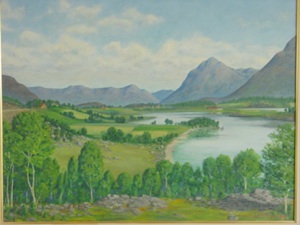
The Meaning of “Knaphus"
“Before he married, Torleif's father (Lars Larsen Slottenaa) cleared and cultivated the land known as "Knaphus" - or "Knap" meaning "knoll” - as in a “hill" or also meaning "button". And "Hus" meaning "House".
Lars built a red, grass-roofed home with a pantry behind it and an animal barn - all on beautiful land that he leased as a cottager (farmer). He was given several local awards for his outstanding skills as a farmer. By trade, he was a talented painter of houses, churches and traditional decorative furniture - skills he taught to Torleif and a couple of his other sons."
The Knaphus Name in Norway Today
Only Torleif's two sisters and his brother Martin remained in Norway. Martin had a daughter Liv who married and still lives in Norway and a son Per Knaphus who immigrated to Seattle. This is why there is nobody in Norway has the last name of "Knaphus". However, the community where the farm once was is now called "Knapphus" - the family name lives on with a location – the old family farm!
About Norwegian Names
Historically, only first or given names were used (like Lars). When communities grew, "patronymic" names were added after the first name (i.e., "Larsen" meaning "Lars's son"). Based upon the fathers' the first names, the patronymic names would change every generation. Later, people added their farm name (i.e., Slottenaa or Alfseiki) after their patronymic name.
Torleif's father was named Lars Larsen Slottenaa (born on the Slottenaa farm). When Lars moved, he took on the newly developed Knaphus farm name as well as the farm name of his birth.
In 1923, a Norwegian law "froze" last names from changing every generation or when people moved to a different farm".
Knaphus
the name






